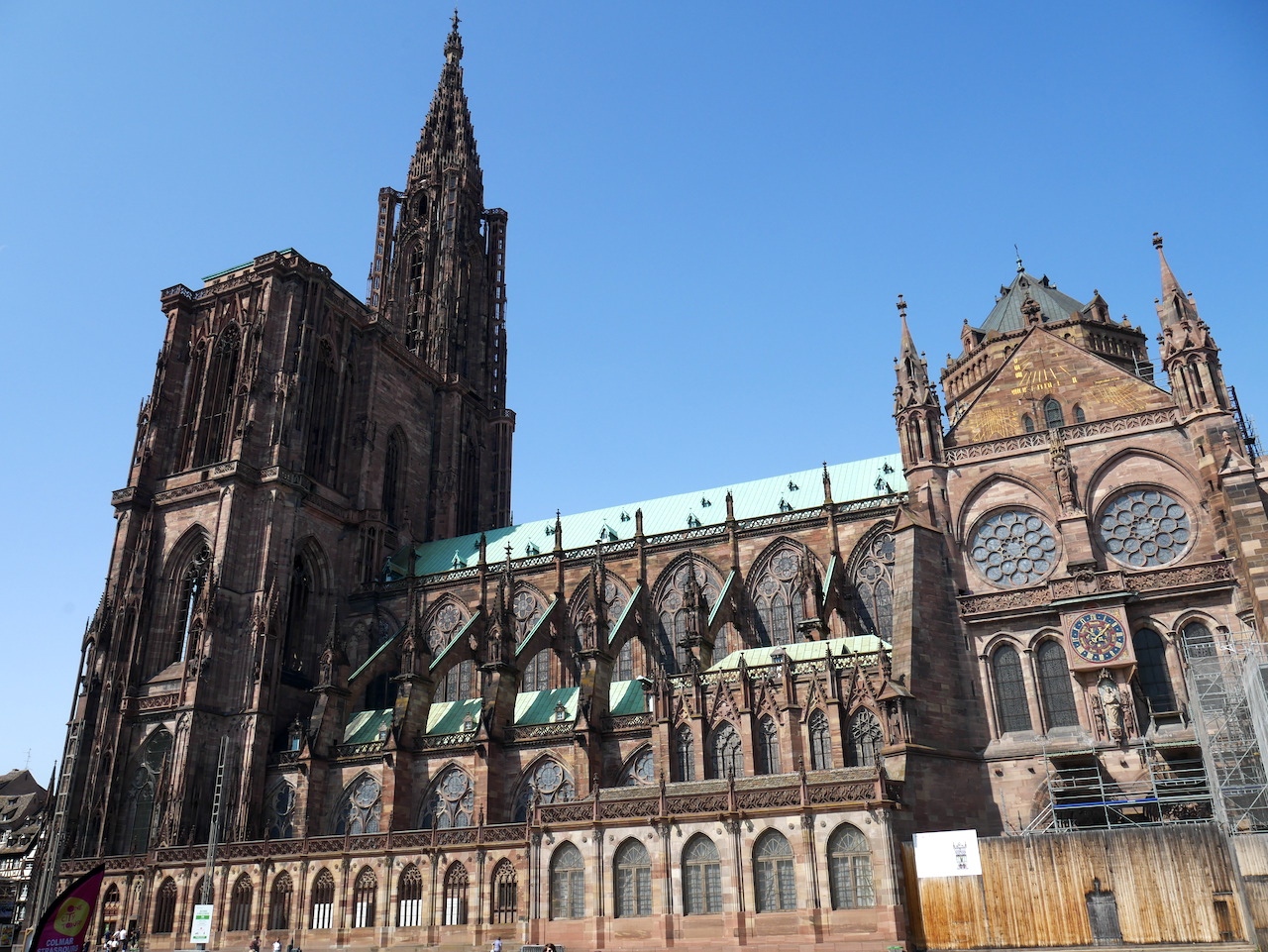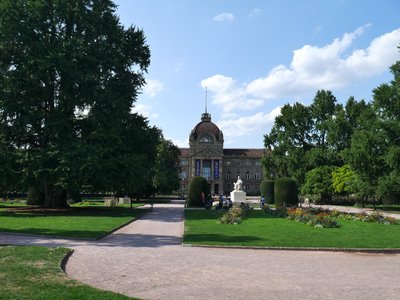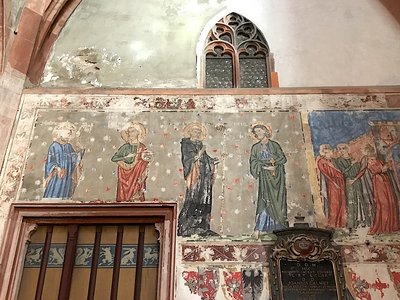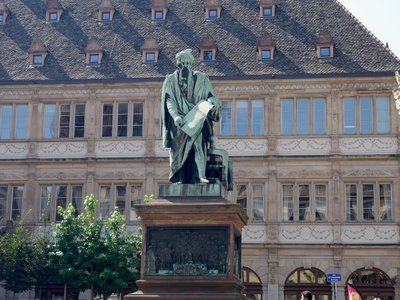
3. Gambsheim to Strasbourg
7 points of interest
 St Columban
St ColumbanChurch of Saint Brigid of Kildare in Kilstett
The name of the town of Kilstett is derived from the name of the three patrons of Ireland, Saint Brigid of Kildare with Saint Patrick and Saint Columba of Iona. The church houses a relic of the Irish saint.
On your walk you will pass through the grounds of Honau Monastery. An Irish foundation in the 8th century on an island in the Rhine. As in the time of St. Columban, the Rhine is a vast swamp with rivers flowing through it, which caused the monks to abandon the monastery of Honau. Today it is impossible to locate the monastery's location, but several churches in the region are named after Saint Brigid. The city of Strasbourg has two churches that bear witness to the Irish presence in Carolingian times.
Réserve biologique de la Wantzenau - Les Amis de saint Colomban TouristWantzenau Nature Reserve
The Wantzenau Biological Reserve has just been expanded into a new biological reserve at the Confluence Ill-Rhine. A remarkable and protected natural area on the banks of these two rivers with their turbulent history.
For more information, click here.
Pavillon Joséphine dans le parc de l’Orangerie à Strasbourg - Les Amis de saint Colomban TouristParc de l’Orangerie in Strasbourg
The Via Columbani arrives in the old city of Strasbourg via the Parc de l'Orangerie.
The city's oldest park is a favourite meeting place for lovers, joggers and Sunday strollers. Children love its playgrounds, its vintage car circuit, its mini-farm and its zoo (free of charge).
It is here that the once endangered stork has been successfully reintroduced. More than 800 storks have seen the light of day since 1971. The beautiful bird, symbol of Alsace, can be admired here in all seasons.
At the western end of the park, you can admire the Palais de l'Europe, which can only be visited by registration.
More information : Strasbourg Tourist Office
Palais de l’Europe à Strasbourg - les Amis de saint Colomban HistoricalPalace of Europe in Strasbourg
The Council of Europe has been based in Strasbourg since its foundation in 1949.
Bringing together forty-seven countries (almost all the countries of the European continent) and representing more than 800 million citizens, the Council of Europe, which has been based in Strasbourg since its foundation in 1949, needed a seat that would fit the bill.
The first "house of Europe" was only a temporary building, and the construction of a genuine "Palais de l'Europe" in 1977 marked the start of the foundation of a vast district devoted to Europe and international relations, on the edge of the large Orangery Park.
At first glance, the Palace of Europe may seem severe: built by the French architect Henry Bernard, it was designed to "affirm, through the muscularity of its exterior plastic, that unity is strength, while at the same time demonstrating, through its smiling and serene interior atmosphere where curves dominate, the confident cordiality necessary for the free confrontation of ideas". The nearby Agora, inaugurated in 2008, fortunately contrasts with this austerity, with its large glass façade and its two atriums around which copper-clad conference rooms are arranged.
Jardin de la place de la République et le Palais du Rhin ancien Palais impérial - Les Amis de saint Colomban HistoricalPlace de la République in Strasbourg
At the time of the German occupation at the end of the 19th century, a district of the city was developed as part of a comprehensive urban planning programme which was to symbolise the greatness of Germany.
Five prestigious buildings were erected there: the Imperial Palace, the Diet Palace of Alsace-Lorraine, the National and University Library of Strasbourg and the two buildings of the Ministry of Alsace-Lorraine, combining different architectural styles (Italian Renaissance, Baroque, Classical) and forming one of the only examples of a "Berlin monumental" type complex.
Further information: Wikipedia
Fresque de Saint-Colomban (robe de bure noire) dans le temple Saint-Pierre-le-Jeune à Strasbourg - Les amis de Saint Colomban St ColumbanProtestant Church of Saint-Pierre-le-Jeune in Strasbourg
Saint Colomban and his companions probably stopped in Strasbourg in an Irish community during their exile around 611.
There are two other Saint-Pierre churches in Strasbourg: the church of Saint-Pierre-le-Vieux, which is actually a complex of two churches, one Catholic and the other Protestant, and the church of Saint-Pierre-le-Jeune Catholic, with its imposing neo-Romanesque dome, which dates from the end of the 19th century.
The Protestant church of Saint-Pierre-le-Jeune is located in Saint-Pierre-le-Jeune Square in the historic centre of the town. It is one of the most remarkable in Strasbourg from the point of view of the history of art and architecture. The church has been Lutheran since 1524, but its history dates back to the 7th century, the century of the expansion of Luxovian monasticism, spurred by the monastery founded by Saint Colomban in Luxeuil. According to tradition, in the marshes north of Strasbourg (La Wantzenau) the monastery of Honau was founded by Irish monks at the end of the 6th century. In the 7th century the monks practised the rule of the good fathers Benedict and Colomban according to the custom practised in Luxeuil.
The church of Saint-Pierre-le-Jeune, which you are discovering, replaced other buildings whose tradition dates back to the 7th century, spiritually dependent on the monastery of Honau whose patron saints were Peter and Paul, it was during the second half of the 7th century that the name of Saint Colomban appeared.
Before visiting the Romanesque collegiate church and its rich history, we invite you to admire the fresco of Saint Colomban (15th century) on the wall in front of you as you enter the church.
This church houses a reliquary of St. Bridget of Killdare. Worship of this Irish saint, part of the trilogy of Irish Patrons, St. Patrick, St. Bridget and St. Columba of Iona, was brought by Irish monks in the time of St. Columba to the banks of the Rhine.
In the 21st century the cult continues in Germany and in several parishes north of Strasbourg including the parish of Kilstett near Gambsheim.
Diese Kirche beherbergt eine Reliquie der heiligen Bridget von Killdare. Die Verehrung dieser irischen Heiligen, Teil der Trilogie der irischen Schutzpatrone, St. Patrick, St. Bridget und St. Columba von Iona, wurde von irischen Mönchen in der Zeit von St. Columba an das Rheinufer gebracht.
Im 21. Jahrhundert setzt sich der Kult in Deutschland und in mehreren Gemeinden nördlich von Straßburg fort, darunter die Gemeinde Kilstett bei Gambsheim.
Guide to visit the church of Saint-Pierre-le-Jeune
Statue de Gutenberg sur la place éponyme - Les Amis de saint Colomban HistoricalPlace Gutenberg in Strasbourg
The statue of Johann Gensfleich Gutenberg was erected in 1840. Although the inventor of the printing press, with individual, melted down characters on demand, was born in Mainz, his discovery was made in Strasbourg a few steps away from his statue around 1435.
Behind the statue you can admire the Strasbourg Chamber of Commerce built in 1585.
Description
Departure from the church of St. Nazaire and St. Celsius via Gruberstraße at the crossroads in front of the church, at the crossroads Bitzigstraße, right rue de la Haute-Vienne, straight ahead rue de Limoges, right rue de la Dordogne
- Left into Rue de la Gravière, right into Kaspersweg, in Kilstett into Denzlachweg, Rue de Denzlach, Rue du Nord, left at the junction with Rue du Lieutenant de Bettignies, after the church second left into Rue de l'Étang straight ahead between the ponds, right into the pond
- Straight on in la Wantzenau, left into rue de l'étang, right in front of the river Ill, quai des Bateliers, at the bridge left cross the river, first path left into the woods
- Right at the crossroads take the Rhine cycle route, stay on the main road Allée de la Digue, right after crossing the river Steingiessen, chemin de la Patrouille, stay on your left Allée des Trois Sapins, follow the river
- Turn right in front of the Koelbesgraben basin, rue Mélanie in Robertsau, at the roundabout turn left onto the cycle path Chemin Goeb, cross the Marne-Rhine canal
- Rue François-Xavier Richter turn right at the roundabout, enter the Orangerie Park, turn right into the Allee de l'Orangerie Joséphine, go around the Joséphine pavilion on the left to exit at the western corner of the Park
- Left, allée de la Roberstau, first boulevard on the right, Boulevard Paul Déroulède, cross the Ill, left, Quai Mullenheim, cross the Boulevard de la Dordogne, right, rue Heckler
- Left rue Jean Hultz, right rue Erwin, left rue Wérinhar, take the footbridge to cross the river, enter the Parc du Contades to cross its entire length through the centre, cross rue Turenne to take rue Auguste Lamey
- Cross the Place de la République on the left, take the footbridge over the canal, turn right onto Quai Lezay Marnésia, turn left along the Place du Petit Broglie, follow the tram to the Place Broglie, rue des Mésanges, second street on the left, rue des Grandes Arcades, walk along the Place Kléber on your left, rue des Hallebardes, second street on the right, you will arrive in front of the cathedral.
- Departure : Saint-Nazaire and Celse Church, 105 route Nationale, 67 760 Gambsheim
- Arrival : Notre-Dame Cathedral, Place de la Cathédrale, 67000 Strasbourg
- Towns crossed : Grand Est
Altimetric profile
Transport
Report a problem or an error
If you have found an error on this page or if you have noticed any problems during your hike, please report them to us here:








